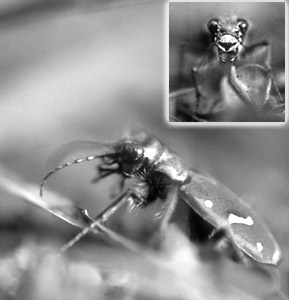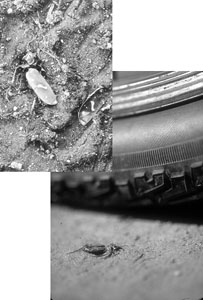![[Metroactive News&Issues]](/gifs/news468.gif)
[ Santa Cruz | Metroactive Home | Archives ]
 Don't Bug Me: Ferocious and predatory, the Ohlone tiger beetle is equipped with powerful mandibles. Tiger by the Trail The Ohlone tiger beetle loves bike trails, thereby putting a bug up local mountain bikers' seats
By Sarah Phelan
ON A SUNNY morning in March, photographer/biologist Mark Oatney tiptoes along a single-track trail that flanks UCSC's Marshall Field. Clad in plaid shorts, T-shirt and hiking boots, Oatney is moving Tiny Tim-style in hopes of getting within viewing distance of an endangered Ohlone tiger beetle, a critter he describes as "skittish." Locals dub this stretch of Marshall Field the "burn spot" because its grasses are reduced to blackened char each summer, a ritual that echoes the grass burnings of the Ohlone people, who once had a village nearby. Today the grasses are bright green and months away from a burn, that is, if it ever happens again. Marshall Field has been declared an Ohlone tiger beetle mating ground, one of only five such sites in the world (and all in Santa Cruz County). The Ohlone tiger beetle, as its big-cat namesake suggests, is a ferocious predator. Lurking alongside trails like the one down which Oatney is currently tiptoeing, this metallic green bug ambushes unsuspecting insects, pouncing on them along the smooth, bare path. Unlike real tigers, these locally occurring beetles only emerge for two months each year, their season's end marked by the bleaching of the grass from an emerald that camouflages their shells to a blond that spells summer death. "There!" whispers Oatney, pointing into the distance. I squint and see a small green beetle dart out onto the path. "Ohlone tiger beetles eat ants, [and] invasive isopods, and I've heard they eat earthworms, which they grab with these incredibly huge mandibles," says Oatney, as a beetle darts toward my foot. Despite such gory details, Oatney believes the beetles' greatest danger comes from mountain bikers, joggers, horseback riders and hikers, in that order. (We'll get to the pigs later.) "Many mountain bikers don't seem to care if they cause erosion or crush beetles. Their mission is to go fast, jump tree roots and bomb down mountain sides," Oatney complains. Off-road cycling is prohibited on the UCSC campus, but Oatney believes campus authorities should take a more proactive stance now that the beetle is listed. "I put mountain bikes at the top of my hit list on account of their speed and continual contact with surface area. But even hikers could kill a beetle, if it was sunning itself or mating," he explains. Trails certainly don't seem like the best place to sunbathe, especially if you're an endangered bug, given that bikers, hikers and the occasional hoofed animal periodically pass this way. But in a Kafkaesque twist, trails like these are the perfect place for the beetles to hunt and mate--provided they don't get juiced midact.
Amazing Graze It's not like Ohlone tiger beetles suddenly appeared out of nowhere. They've have been scuttling throughout our coastal prairies for hundreds of thousands of years, but why the trail-hugging lifestyle? Most biologists blame it on Pleistocene megafauna, giant grazing animals that trampled the rippling coastal grasses, thereby creating conditions the beetles found attractive. Once the megafauna died out, some anthropologists maintain that the native peoples burned the coastal prairies to prevent fires, control invading brush and promote the growth of their favorite flowers and grasses. European guns and germs mostly wiped out the native peoples, but their cattle helped keep the grasslands beetle-friendly. Whatever the history, our collective beetle blindness ended 12 years ago, when naturalist Randall Morgan spotted some "brilliant green, wary and hard-to-catch beetles" in Soquel on a grassy knoll above the drive-in. Coincidentally, a friend had just sent him a box of insects which had been collected on the UCSC campus in the 1980s. "One of them was identical to the beetle I found in Soquel," explains Morgan, "which means the UCSC beetle really was the first. And since that one was from Marshall Field, which was once an Ohlone village, I decided to call it the Ohlone tiger beetle." Describing the beetles as "bright, active predators, very particular about the places in which they choose to live, places which have been hammered by development," Morgan mourns their loss of habitat. "I cry when I think about the way we have treated the grasslands, which once must have been covered with wildflowers, an incredible tapestry to walk through, an incredibly diverse patchwork of which the Ohlone tiger beetle is just one fragment." These days Morgan isn't the only one crying. In October 2001, 10 years after Morgan first petitioned U.S. Fish and Wildlife Service, the Ohlone tiger beetle was officially listed as endangered--a listing that has triggered another round in a bitter battle about land management, as the first generation of beetles to be federally protected emerges on both public and private land. No Porking A short hop from Marshall Field, more Ohlone tiger beetles have been sighted, this time in the state-owned Gray Whale Ranch on a 200-foot section of Chinquapin Trail--an open rolling path popular with cyclists, hikers, equestrians--and greedy wild pigs. Oatney points to a patch to the side of Chinquapin Trail that looks as if it's been rototilled. "Pigs destroy the smooth surfaces beetles need to hunt and mate," he says. Last year, the Department of Parks and Recreation trapped 300 pigs, a step rangers think explains this year's beetle emergence on Chinquapin Trail, with 58 adults counted on one day alone. "For us, that means something is going very well up there--a very positive sign," says state ranger Ralph Fairfield. In response to this emergence, the DPR posted notices instructing cyclists to dismount and walk their bikes, because of "sensitive wildlife habitat." The explanation was left deliberately vague, say park officials, to protect beetles from poachers. Being less-than-explicit creates problems, too, judging from photos Oatney has shot of cyclists gaily zooming past the notices--and of beetles lying crushed on the trail. "More carnage!" says Oatney, dropping to his knees as he spots another squished beetle. With its legs splayed out, it was nearly crushed to death, but whether cyclists are responsible is unclear to me, as I stoop to examine the broken carcass, pieces of which are scattered on the path. "Having trouble with the living?" I whisper in my best Beetle Juice voice to a pair of emerald forewings, which I spread out admiringly on the pages of my notebook. As we prepare to retrace our steps, State Parks resource ecologist Tim Hyland drives up with news of five flattened beetles further along the trail. When asked how the DPR proposes to stop more beetle deaths, Hyland, who looks dressed for an African safari, says that if the DPR closes trails completely, "we'll eliminate habitat, so we would only close the trails during mating season. People phone us saying, 'Get those mountain bikes out.' Others call demanding we provide recreation. Meanwhile, there's this gorgeous beetle running around. We only have two rangers for the whole North Coast. We are very understaffed."
Post It Within days of my tour, UCSC authorities fence off trails in Marshall Field and post illustrated signs prohibiting access during the beetle's mating cycle. Meanwhile, the DPR leaves Chinquapin Trail open and the beetle unidentified, a move which frustrates Oatney, who, jumping out from beneath a trailside tree, photographs the mostly young and male cyclists blatantly ignoring the "walk-only" and "sensitive wild habitat" signs. Oatney's frustration is shared by Mountain Bikers of Santa Cruz, a local cyclist advocacy group that has posted photos of the beetles on its website to help members identify and avoid injuring the bugs. "It doesn't make sense to only post the area as a walk zone," says MBOSC's David Baskin, who thinks that an honest and detailed explanation of what's at stake is necessary. But he also accuses U.S. Fish and Wildlife of having been way too quick to regulate mountain bikers. "There is no proof that mountain bikers are any greater threat to the beetle than a group of runners, hikers walking four abreast, or a couple of horses. Couldn't a ranger driving down the trail or a hiker wandering along trails examining wildflowers squash beetles, too?" he says, adding that despite these concerns, MBOSC is encouraging all cyclists to get off their bikes and obey the signs as a gesture of goodwill. Curious as to why two state-owned organizations (UCSC and DPR) are managing their land differently for the same endangered bug, I contact U.S. Fish and Wildlife biologist Colleen Sculley. Sculley says it seemed reasonable to close the trails in the UCSC-owned Marshall Field, since off-road cycling is already illegal on the campus. "State Parks didn't want the Ohlone tiger beetle advertised on their property for fear signs would attract beetle collectors and vandalism," says Sculley. "But we are encouraging them to post better signs." Back at the office, I talk with longtime cycling enthusiast Dan Nall, who works for bicycle helmet manufucturer Bell Sports (www.bellsports.com). He wants to know how State Parks got permission to put up "those hideous yellow ribbons and fences and uglify the area." Nall is on a roll. "If this beetle is only found in five places, maybe it's no longer viable as a species. If the beetle's going to survive, it's going to have to adapt its habits. First it was the red-legged frog, now it's the Ohlone tiger beetle. What'll be next? Where do you draw the line?" Grey's Gray Biologist Grey Hayes doesn't think of himself as an enviroterrorist, though Nall no doubt sees him that way. Hayes, who drives a red Toyota pickup festooned with bumper stickers saying "Keep Wilder Ranch Wild," is currently working on his doctorate on grassland restoration, and thinks some amount of trail use is good. It's the erosion and the speed of bikers he worries about. Hayes says if he could have his way at Gray Whale Ranch, he'd "maintain short, growing vegetation, install a huge stop sign and big steel gates across the road, put nice, friendly, easy-to-follow detour through meadows, thereby making new habitat, and change trails from one side to next, from left to right in alternate years." He'd also work to get grazing going. "Only since our modern conservation movement set aside grasslands for state parks has there been no grazing and no burning. Land management isn't a democratic institution," says Hayes. "The first thing State Parks did when they got Gray Whale Ranch was to remove all management."
Just Ax Him "State Parks is not without blame, but Grey Hayes has an ax to grind," says the DPR's Tim Hyland. "Grey's thing is that 'You aren't doing enough to protect the beetle,' but we probably have about 300 beetles, so we are less worried about a certain amount of attrition than we are about the trail closing up." Adding that the DPR "will allow a certain amount of take, meaning beetles that get squished or collected," Hyland notes, "There have been no squashed beetles in the past week and a half. Our understanding is they are like salmon in that they breed and then die." As for Nall's concerns that eventually the beetles will be everywhere and that the DPR will be closing all the trails, Hyland says that even under ideal management conditions, the bugs aren't likely to spread. "The truth is they are rare and found only on isolated patchy places, as is the case with a lot of endangered species," Hyland explains. "The beetles are specialists, who have filled a little niche." His concern is that people use the trails not just to create beetle habitat, but to be aware of the treasures contained therein. "There's this built-in dichotomy," he says. "Without exposure, people won't know what's at stake, and they'll overturn the Endangered Species Act." But while Hayes has accused the DPR of mismanaging Gray Whale Ranch in the past, they seem to be taking some of his advice and are even looking into getting permits to burn. But it's unclear whether UCSC will burn Marshall Field this year, now that the beetle is protected. "At this point we're trying to understand the science and biology of the species," says Charles Eadie, campus and community planning director at UCSC, noting that the beetles are in open meadows that are not slated for development. "Funnily enough, all those illegal bike paths are potentially creating better beetle habitat," he says. "It's tricky stuff."
For further information, check out these websites:
www.oatney.com/endangered_species
[ Santa Cruz | Metroactive Central | Archives ]
|
From the April 24-May 1, 2002 issue of Metro Santa Cruz.
Copyright © Metro Publishing Inc. Maintained by Boulevards New Media.
 Cycle of Destruction: Photographer Mark Oatney captures candids of cyclists ignoring warnings to walk their bikes in sensitive habitat.
Cycle of Destruction: Photographer Mark Oatney captures candids of cyclists ignoring warnings to walk their bikes in sensitive habitat.

 The Treadful Truth: When the Ohlone tiger beetle meets a mountain bike, only one survives.
The Treadful Truth: When the Ohlone tiger beetle meets a mountain bike, only one survives.